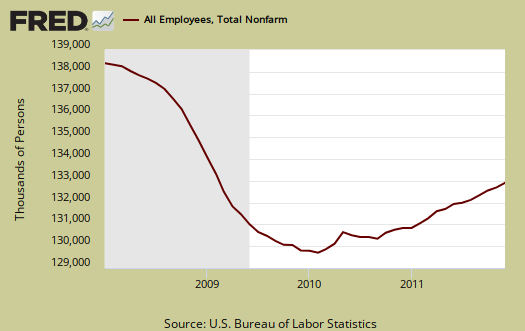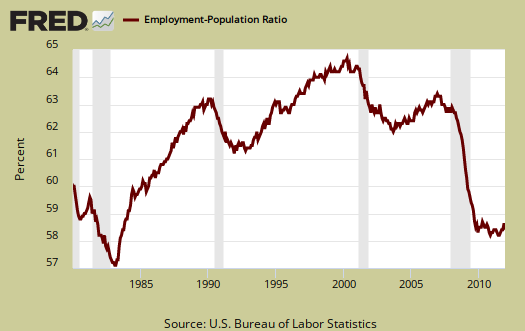The December 2011 monthly unemployment figures show the official unemployment rate dropped -0.2 percentage points to 8.5% and the total jobs gained were 200,000. Total private jobs came in at 212,000. Government jobs dropped -12,000. Temporary jobs also dropped -7,500. All other major job categories had payroll gains. Manufacturing gained a much needed 23,000 jobs.

While the BLS seasonally adjusts reports, taking into account Christmas hiring, this report shows a gain of 50,000 jobs in transportation and warehousing. 42,000 of those jobs is with courier services, i.e. UPS and Fed-Ex. We know online shoppin' has really taken off, but lets hope those delivery and shipping jobs reported permanent really are.
The BLS also revised October and November payrolls:
The change in total nonfarm payroll employment for October was revised from +100,000 to +112,000, and the change for November was revised from +120,000 to +100,000
Below is the nonfarm payroll, the total number of jobs, seasonally adjusted. Since the start of the great recession, declared by the NBER to be December 2007, the United States has officially lost -6.083 million payroll jobs. That does not take into account additional jobs needed to employ the United States increased population, but does include the jobs added over the over the almost four years, or 47 month time period.

Below is a running tally of how many official jobs permanently lost since the official start of this past recession. Increased population growth, implies the United States needs to create at least 10.06 million jobs or self-employment. This estimate assume a 62.7% civilian non-institutional population to employment ratio, as it was in December 2007, which implies an additional 3.97 million jobs were needed over a 48 month time period beyond the ones already lost.

If one takes the current civilian non-institutional population, 240.584 million, and the December 2007 to employment ratio and then subtracts off the current number of payroll jobs, 131.9 million, the number of jobs to get to pre-recession levels is much worse, 18.95 million jobs. This number doesn't take into account population subset fluctuations, for example, those retired percentages increasing. It also isn't taking into account agriculture workers and self-employed, currently at 2.349 million and 8.587 million, respectfully. It's hard to believe agricultural workers increased 87,000 in a month, but that's what this month report shows. Finally this estimate is mixing two different survey numbers, the CPS and the CES. Reported Payrolls only counts nonfarm jobs, no matter how many hours of work they actually are. Many people work 2 to 3 jobs to get by.
8.098 million of the 26.47 million part-timers working low hours are doing so because they cannot get full time jobs. The number of forced part-timers who can't get full-time work, also known as part-time for economic reasons, has dramatically dropped, by -371,000 this month. We'll have more about forced part-time, as well as other topics and data points, in additional overview articles.

The increasingly low labor participation rate is now at 64.0%, and no change from October. If we go back to December 2007, the labor participation rate was 66%. The highest civilian labor participation rate was in January 2000, at 67.3%. What this means is there are over 4.81 million people not be accounted for in the official unemployment rate, in other words counted as employed or unemployed, who probably need a job and can't find one. That's in addition to the official 13.097 million unemployed.

The employment to population ratio is now 58.5%, no change from last month and at record lows. You have to go back to the severe recession of 1983, October to find such low ratios. The uber-low ratios are not a structural change, such as all families decided to have a stay at home caretaker, or magically a host of people could retire early, or magically all young people went to school as some want to claim. The low employment to population ratio are people dropping out of the labor count.
These numbers are important because unemployment is a ratio, percentage or during a limited time period, the number of people actively looking for a job and counted. Many people are not counted in the official unemployment statistics, yet when looking behind the official numbers it's clear America has more potential workers and less jobs in so called recovery than during one of the worst post WWII recessions.

One needs at least 86,000 and some estimate up to 225,000 permanent full time jobs, added each month just to keep pace with U.S. civilian workforce population growth. That's not general population, that's the group needing a job.
January 2012 will finally incorporate the 2010 Census numbers for increased population in the BLS Household survey. Not only will this affect labor participation and employment to population ratios, but it will also give a improved non-institutional civilian population estimate, upon which calculations to figure out how many jobs are needed each month for population growth, are based.
The United States has jobs crisis going on for over 48 months! While this report has some great news, one month does not 30 million jobs needed make.
Here is last month's unemployment report overview, unrevised. We'll be overviewing more statistics from the unemployment report in additional posts.

Recent comments